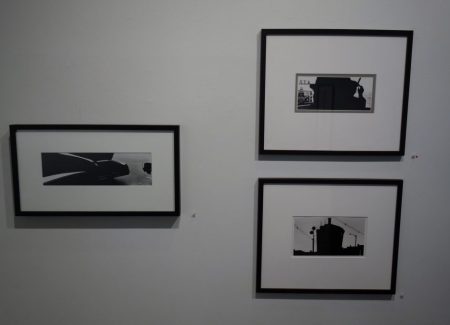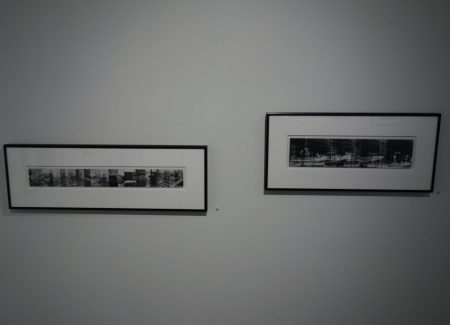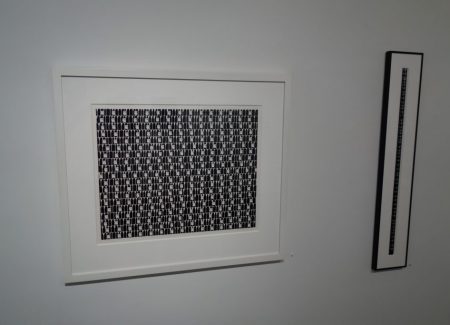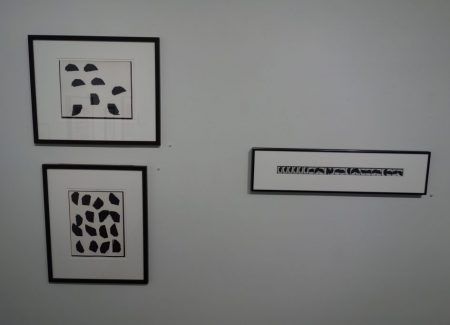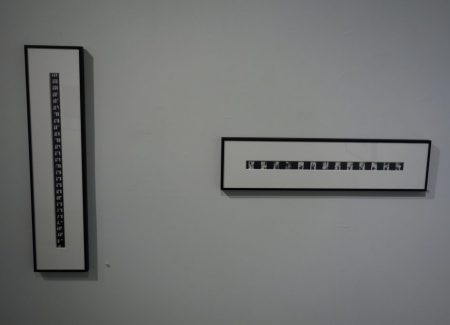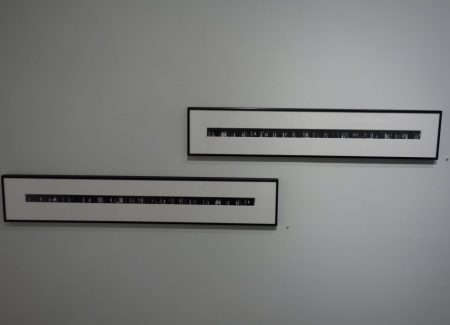JTF (just the facts): A total of 31 black and white photographic works, framed in black/silver/white and matted, and hung against white walls in the main gallery space and the front entry area. All of the works consist of gelatin silver prints, either as single images or strips/sets/composites, made between 1959 and 1983. Most are vintage, while a handful were printed later. The 19 strip pieces are roughly 1 to 4 inches tall and 10 to 36 inches long. The single frame works are sized between 6×6 and 10×10 (or reverse). And the composites are sized 39×26, 14×14, 29×33, and 20×16. While some of the works on view are unique, many are available in editions sized from 2 to 25 (not always fully completed). (Installation shots below.)
Comments/Context: Most often, when we set out to measure the greatness of a photographer, we do the following: we gather up his or her widely acknowledged best images, hang them together, and then begin the process of assessing the high points in that artist’s career. Such an approach seems simple enough to be sure. But what if we were to look at a photographer’s output from the other side, from a selection of b-sides, outtakes, secondary images, and stuff on the cutting room floor – what might we think then? Would we still see the greatness we so easily discover in the best of the best?
For the vast majority of photographers, I’d hazard to guess that such a contrarian examination might not yield much of durable interest, except for ardent fans and scholars. But Ray K. Metzker was no ordinary photographer, and as this show of (for the most part) previously unexhibited works demonstrates, the work left hiding in the boxes after his recent death can easily stand our scrutiny. In fact, the overlooked works here (that were generally left out of his recent comprehensive retrospective) are more sophisticated and accomplished than the best output of many we regard with honor.
When we tick off Metzker’s usual classics, we tend to start with the luscious deep blacks of his carefully managed city scenes and end with the all-over density of his composites. But what this show does so well is that it connects the dots between the two, both visually and conceptually.
Back in 1959, Metzker quietly began the process of lighting a match to the conventional “decisive moment” wisdom of single image photography. Starting with a simple contact sheet-like grid of images of a city stairway (memorably adorned by a backlit child with a balloon down in the corner), he began to make a photographic argument that multi-frame imagery could tell us something more – about place, about elapsed time, about shifting light, about in-betweenness, about so many things.
A few years later, he seems to have made a small discovery among his various rolls of film. In a few cases, adjacent frames on the roll had deep blacks along the touching edges, so much so that the two images seemed to be continuous, even though they might depict unrelated subjects. These kinds of pairs became his so called “Double Frame” works, where shadow silhouettes of pedestrians or city buildings came together, the back-to-back combination pulling the sweep of an overpass into the open trunk of car.
What came next was a conscious attempt to extend this continuity of imagery across an entire roll of shooting. That this ever worked, that he strung together dozens after dozens of seemingly perfectly sequenced images without error or misfire boggles the mind. And yet, there are plenty of these smart “Stripteases” on view here, where we see him deliberately playing with camera rotation, alignment, framing, and progression, taking a single idea and extending again and again, the patterns of the frames ultimately breaking down the content of the subject and raising us up to a different level of overall abstraction. A storefront window, a telephone booth, a look skyward between dark skyscrapers, even simply passersby on the sidewalk – they are all transformed by this process of methodical repetition and iteration.
From there, Metzker introduced multiple exposures, and this again is conceptually and practically astonishing when we think about it more closely. Shoot a frame, rewind the film, shoot again (on top of the first exposure), advance, shoot, rewind, shoot, advance, back and forth, in lock step, all without error. This experimentation allowed Metzker to take the strips further – he could now overlap adjacent frames (reversing half or a third rather than a full frame), double images, insert black strips, and create continuous flows that seemed to interlock and combine. He applied this sophisticated seeing to female nudes in silhouette (creating interwoven ghosts of dark and light), to portraits taken with horizontal and vertical striped lighting created by blinds, to chaotic jumbles of overpass traffic, and to the angled views of streets and sidewalks combined into criss-cross Xes and step-wise undulations.
If this wasn’t conceptually and technically mind blowing enough, Metzker then went one step further, combining the multiple exposure strips into his all-over composites (several strips mounted together as one work). That these works dissolve into geometric abstraction seems like the final blow to the “decisive moment” – time is entirely malleable (or perhaps untethered), methodically pushed and pulled by Metzker into something much richer and rounder than one single instant. The composites have a continuity that often feels endless, as though we’ve been time-sliced into some other dimension.
That we can derive so much information from these unheralded fragments and bypassed efforts is certainly surprising. While Metzer’s composites have always been in my mind his landmark works, this show patiently and clearly explains how he got there (even if the ideas were more fluid and overlapped than my explanation might imply), only increasing my admiration for what he accomplished in these works. This is a “think-it-through” kind of exhibit, and if you are willing to invest the effort to follow the incremental logic of what Metzker was doing in these various pieces, it delivers a satisfying dose of impressively masterful photographic intelligence.
Collector’s POV: The works in this show range in price from $4500 to $145000. Metzker’s work has only been intermittently available in the secondary markets in recent years, with recent prices ranging between roughly $3000 and $69000.

